Information philosophy, part 7, final. System formation
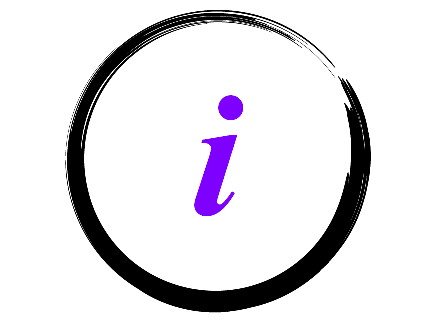
The end of a seven-part fairy tale that started from here .
Readers quite rightly complained that in previous chapters there were many cleverly coiled abstract theoretical constructions with not obvious practical utility. In the last chapter we will try to concentrate on purely applied and very vital aspects.
Content
Chapter 7. System Formation
This chapter is purely applied, and no fundamentally new concepts will be introduced here.
')
Self-organization
Briefly, the question of system formation in general form can be formulated something like this: what are the reasons for the emergence and successful functioning of purposeful actors?
Any question about the reasons for transferring it from the field of pure curiosity to the area of practical interest automatically splits into two particular questions about creation and prevention. In this case, questions can be formulated as follows:
- What needs to be done so that, according to our desire, purposeful actors emerge and function successfully where their appearance is desirable for us?
- What should be done in order to prevent the emergence and / or successful functioning of those purposefully acting actors that are not desirable for us?
The first question is much more interesting than the second, since the answer to the first question largely contains the answer to the second.
It so happened that the consideration of the problem of self-organization traditionally starts from a position “from scratch”, that is, from an attempt to find ways of spontaneous transformation of dead chaos into living self-sustaining order. There is certainly some theoretical interest in this, but on closer examination it turns out to be not as great as is commonly believed. First of all, this is due to the fact that in questions beginning with the words “what to do in order for ...” , it is already a priori assumed that some living order has already arisen from the original mechanistic chaos. At least in the form of us with you.
We create and support
Speaking about the creation of systems, we will proceed from the fact that there is already a subject (for example, we, thinking and existing), which has an external (otherwise it does not happen) goal-setting, and there is some initial situation. The desired result directly, in the style of “come and take,” is unattainable. Schematically, this can be represented as:
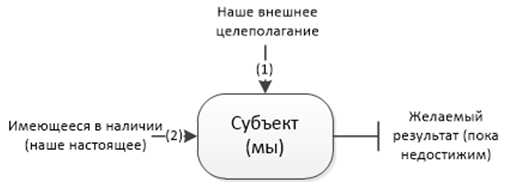
Initial state for system formation
If we talk about information, then “available” is a complex of signals coming in by the arrow (2), and “external goal setting” is the context entering from the outside by arrow (1). Combined with each other, they provide information, and this information is still disappointing.
Structurally, the notation is similar to the IDEF0 notation, and this is not surprising. There, too, it is assumed that the result is obtained on the combination of the source data, indicated by the arrow entering the block on the left, and the control flow, indicated by the arrow above. Ideologically, this approach is in very good agreement with the “signal + context” construction.
Immediately, I note that in this scheme, the subject is not necessarily a living being in its entirety. Both the initial prerequisites, the goal-setting, and the desired result — all this may well be just one particular aspect of the fullness that we call our life.
The first thing that comes to mind in such a situation is to find some suitable soulless tool and solve the problem with it. A hammer, ax, shovel, matches, calculator, piece of paper, or something else. Depending on the problem to be solved. It turned out like this:

Tool acquisition
An expanded subject has appeared, which is fundamentally no different from the original subject. Hammer as a continuation of the hand, a piece of paper as an external storage device. The picture is not only strongly reminiscent of the “controlling subject / controlled object” construction adopted in cybernetics of the 20th century, but it is. The subject is the control system, the tool is controlled, the arrow (3) is the control signal, the arrow (5) is feedback.
In an amicable way, an arrow would also have to go from the subject to the desired result (for example, while one hand hammers a nail with a hammer, the other hand holds this nail), but it is lowered so as not to confuse the scheme.
If instead of achieving the result with the help of a soulless tool, we solve the problem by enslaving someone, the picture will turn out like this:

Finding a slave
In order to avoid gossip, just in case, I immediately note that the enslaved need not necessarily be a two-legged creature. A slave can be four-legged, flowering, single-celled, generally incorporeal (for example, an ecosystem), or whatever. The essence of what is happening does not change. In addition, slavery may not be total, but temporary, from eight to five with a lunch break.
The overall situation is similar to the use of a soulless tool, except that we now need not only to command our tool (arrow 3), but also to motivate it (arrow 6). That is, to organize him an external goal-setting. And do not forget to block the external goal-setting, which he had by nature (arrow 7). If you leave at least a little bit of the natural goal setting of the slave, then the desired result will be the interference of the two goal setting. We do not expect this from an instrument that implicitly performs our and only our will.
If a slave is an artificial system, then he does not have any goal-setting "by nature", and there is nothing to block.
Since only our goal setting remains in force in the resulting construction, there can be no talk of the appearance of a composite subject, and only an expanded subject still exists.
Similar to the previous scheme, an arrow is not shown, going from the subject to the desired result, which will always take place if the subject and the slave work on the desired result together.
The “slave acquisition” scenario should not be confused with voluntary help. With voluntary assistance, there is no need to block the existing goal-setting of the employee, and therefore, although formally the situation of volunteering may be similar to using a person as a tool, but this is not slavery.
It can be noted that slavery is a very dreary occupation. It is necessary not only to command a slave, but also to engage in his goal-setting. Maybe the process can somehow be automated? For example, let a properly educated and perfectly trained slave himself receive our goal-setting and do everything himself correctly? A very good option is to create either an entirely artificial subject, that is, to bring automation to complete the task to perfection. Or create an impersonal structure (the slave does not have to be a living multicellular being, it may well be a well-educated "Mouse") that will provide an acceptable satisfaction of the need for all. Result:
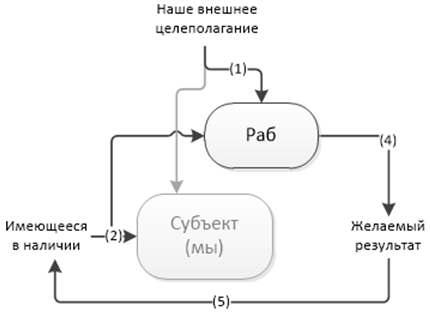
Task delegation
Fully automatic process. We did a good job, created an ideal slave, now we get the desired result, without putting any additional effort on it. Life is Beautiful. Or still not quite? There is a feeling that I had to sacrifice something. Specifically, by itself. We have turned from a deliberately acting subject to a peacefully watching gaze. Maybe it makes sense to remember that we are also able to do something, grow an arrow on our right side and send ... where? To the desired result - not necessary. We have a very good slave, and he does an excellent job himself. Maybe send an arrow on the slave? But why? He has all the initial data, goal setting as well. We can add nothing to what the slave already has. We with his “valuable instructions” will only disturb him. By all the formal features, everything is fine with us (we received and continue to get the result we were striving for), but in fact we have ceased to exist.
A slave, tired of struggling alone with problems, hires a slave for himself, and the result is this:
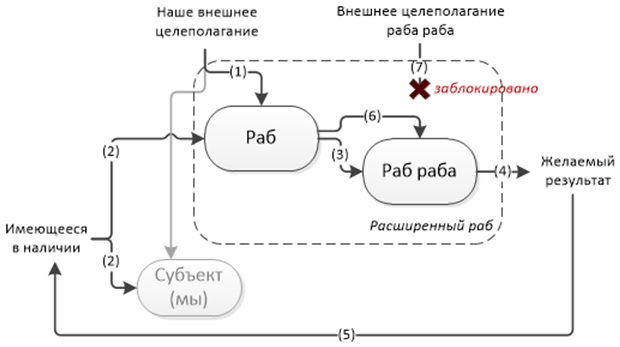
Police officer protects the peace of civilians
Yes exactly. Police officer guarding the peace of civilians. In the role of a slave, the government we created, and in the role of a slave slave, a police officer. We delegated the care of our security to the government, and got what we wanted. Now, according to the set of “security” goals, we have ceased to be subjects. In this scheme, firstly, it is interesting that the picture depicted is what it would be if everything was done absolutely correctly and reliably. In reality, in addition to delegated goal setting, the government also has a certain amount of additional goal setting, which can be called the “corporate interest”. And the goal-setting of a police officer to the end is never blocked. As a result, we, citizens, get what is not known, having paid for this monstrous price.
It makes sense here to immediately note that, as far as I know, the system formation of states never took place under the “delegation” scenario. Everywhere, where governments declare the so-called "service to the people", there is a fair share of guile. Relationships of the people and the state are based on other scenarios, which will be discussed below.
The second thing that is interesting in this picture is that the “expanded slave” on it is constructively no different from the “extended subject” in the picture “Finding a slave”. Accordingly, the situation tends to evolve into the delegation of the task, in which the slave loses subjectivity, and the only actor becomes the slave slave. Got a self-replicating structure. Slavery is replaced by delegation, interception of subjectivity and care for the next round. The system acquires new slaves and pushes yesterday's masters out of the process, taking away their goal setting. Some subjects are drawn into the system, while others erupt. It can be assumed that the erupted former masters are the best candidates for the position of new slaves. They, who have not completely forgotten the lost goal-setting (1), will more easily accept any other creatures from the new owner a new substitute goal-setting (6).
I would least like to give some moral assessment of what is happening. You just need to understand that the described scenario happens, and is one of the very common patterns of development of the situation. It can even be assumed that we ourselves are in many ways the result of a complex, lengthy and multi-stage chain of delegations scrolled through a large number of aspects of life activity. But the logic of the self-copying pattern is such that after having been on the crest of the process wave and having made our full subjective contribution to it, we very much risk ourselves becoming former masters of life excluded from the process. And then the prospect - or in non-existence, or in the hiring of former slaves. Residents of developed countries have already advanced further than others on the way of delegating tasks. Already delegated and the extraction of food, and domestic arrangement, and the development of ideas about good and evil (this happened even before many other things), and security, and care about their own health, and even the cultivation of offspring. Scattered scraps, temporarily not intercepted by the servants created by us, remained from the original natural external goal setting. Science fiction frightened us that the artificial intelligence generated by us would arrange a war of annihilation against us. But such an outcome is extremely unlikely. It is much better to see the prospect that the Matrix will satisfy any needs before the person has time to think about them, and SkyNet will eliminate any inconveniences even before they manifest themselves. It is cozy. It's comfortable. It is satisfying. From this you do not want to go back to where it is hungry, cold and dangerous. And for my part, it would be the greatest swinishness to call for the return of humanity to the primitive order so that everyone would have the opportunity to have fun with poverty, disease and war.
Fortunately, the “slavery” and “delegation” strategies are not the only ways of system formation. Moreover, it is easy to see that these strategies do not lead to the formation of composite subjects, including the subject that existed in the first step. The maximum that can be achieved in them is the appearance of an extended subject. The compound subject arises where cooperation appears.
Consider first, in a certain sense, a degenerate case - a situation in which the subjects work for a common result, but do not interact informationally with each other:
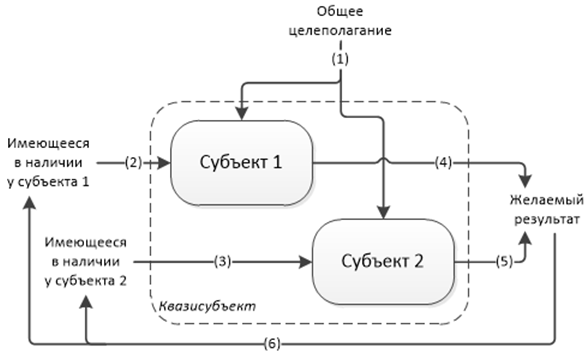
Strategy "if everything ..." (or, alternatively, "if no one ...")
In this case, the desired result is unattainable by the forces of one subject, but the efforts of two subjects are easily achieved. Subject 1, guided by purpose (1) and the fact that he has available (2) contributes (4) to the common cause, and has profit from it (6). Subject 2 comes in the same way. Everyone is happy, the result has been achieved. An external observer who looks at the total set of “subject 1 + subject 2” may have the overall impression that the system is working. In principle, it is not very far from the truth. Such a “black box” definitely gives a systemic effect, and this is not surprising. Although the subjects do not directly interact with each other, the interaction still takes place through the desired result and feedback. From the point of view of the subject involved in the process (subject 1 or subject 2), the systematic nature of such a system is not so obvious. He knows that everyone acts on his own.
There are usually two problems with such an organization of affairs:
- Such systems do not want to take shape. Subject 1, having come to the field of activity, soberly assesses his strength and comes to the conclusion that the result is unattainable. And if so, then in this case his purposeful activity is meaningless. The same happens with the second subject. Such systems, in principle, can develop when the scale of the problem increases gradually. At first, the first incoming subject copes with the task, and then, when he has already ceased to cope, but he has not yet had time to decide to drop the case, a second one appears.
- Such systems are unstable. As soon as the required contribution to achieve begins to exceed the capabilities of one of the subjects, he almost immediately abandons this hopeless affair, and then the process of disintegration is already going through an avalanche. Another danger to such a “system” is the temporary reduction in the need for effort. As soon as someone felt that everything was working out without him, he left to do other things, and when after some time he returned, he was surprised to find that he was leaving in vain and came back too late.
Every time we indulge in idle dreams about how good it would be if everyone suddenly began to do the right thing, we rely on system formation in the scenario described here. We are counting in vain. Even if it happens, it is very short. “If everyone cleaned up after themselves and didn’t litter ...”, “if everyone kept the traffic rules ...”, “if no one stole ...”, “if everyone voted for the right candidate ...”, “if everyone worked for the common good ... ”- these are all dreams of system formation without system formation. It is easier to admit that there is no such thing in real life than to waste time on waiting for a miracle.
In order to bring the scheme to something more sustainable, you need to make sure that the subjects begin to communicate with each other. Add data transfer from subject 1 to subject 2 and vice versa:

Established data transfer between subjects
Unfortunately, this innovation will not give us anything. We reached the signal, but there is no context for it, and therefore the signal does not become information. The context that was, is no good, since it is not about communicating with his own kind, but about the desire for a result. Moreover, it is completely incomprehensible that it induces the subject 1 to give the signal (7), and the subject 2 - the signal (8). In order to solve these problems, it is necessary to provide the subjects with additional contexts:
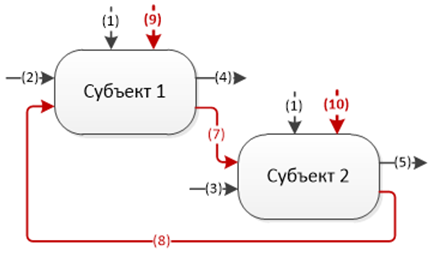
Added contexts
Context (9) allows subject 1 to interpret signals (2) and (8) and not only generate a signal (7), but, possibly overlapping the context (1), influence the outgoing signal (4), which forms the desired result. The context (10) works in a similar way in subject 2. Contexts (9) and (10) may be the same context, but they may differ.
The main difference of contextual arrows from signal ones is that they are not something coming from outside. A signal is really something that affects the subject from outside its limits, but the context is not a signal, but information, which in turn is a “signal + context” construct. Thus, the arrival of a context from the outside is a certain convention. From the point of view of how the subject himself understands what is happening, the incoming context is indeed something that is “given” from the outside, but in reality the context is an element of the subject's contraction. Since the whole structure must as a result operate in concert, it is necessary that the contexts (9) and (10) match each other. Moreover, two times: the signal (7), generated using the context (9), should be understood in context (10), and the signal (8), generated using the context (10), should be understood in context (9). The functioning of the interaction of subjects is a systemic effect of the mechanisms that form contexts (9) and (10). Consequently, their combination can be considered as a single system that is part of a composite subject:

Added consistency of the subjects of interaction
One could not add the added system a dotted line, because in any case, the rigid boundaries of the subjects and their localization anywhere else are always a convention.
Obviously, the communication system we have turned out to be some kind of defective creature. Outgoing signals are there, but where are they coming from? In order for the system to issue consistent signals, it is necessary that it has goal setting and input data. With the source data, everything is clear: there is nothing except arrows (2) and (3). As a goal-setting, you can try to take the initial goal-setting of subjects, but it will turn out badly. It turns out that for the shooter (9) this is the result of working in the context of (1) signal (2) plus in some mysterious way through subject 2 of the received signal (3). There can be no such mysticism, since we already have an arrow (8) to receive the signal (3) through subject 2, but it will not work without context (9). If we need a context for the functioning of the communication system, which is nowhere to take within the system in question, this means that we will have to take it from the outside. The resulting scheme of joint work of interacting actors on the overall result:

Joint work on a common result
Interestingly, such a scheme will not fall apart if you completely remove the general goal setting (1), knocking down all the external context on the goal setting of the communication system:
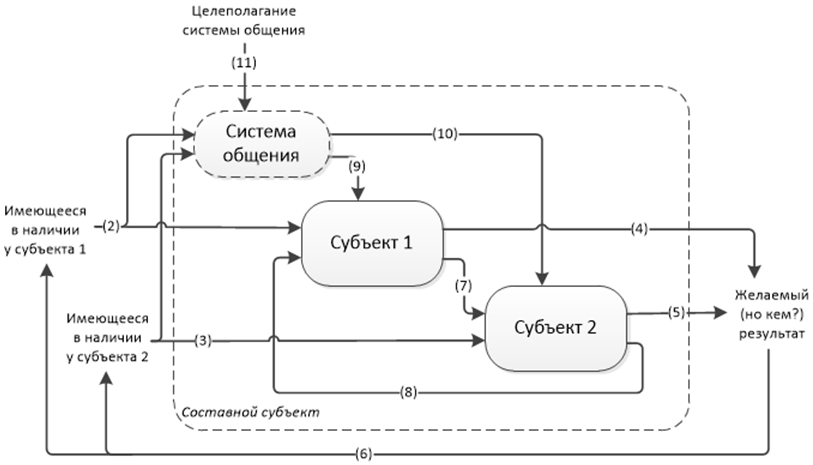
Valuable communication
Subjectively acting actors, the situation will be perceived as something that they really want to interact with each other. Maybe they even come up with some kind of logical explanation for complacency, but this is not necessarily and not important.
Let's see what happens if the interacting subjects work not for the common, but each for their own results. Subjects remain, but each receive their own goal-setting. The system of communication remains. The desired results becomes two. The benefit for the subjects (the motive to enter into interaction) can be realized in two ways:
- The result of the work of each of the subjects is not only their own desired result, but also the desired result of a friend. The situation is "you to me, I to you."
- Each works only for his own result, but obtaining the desired result of each subject contributes to the improvement of the quality (and, therefore, utility) that is available not only from himself, but also from a friend. The situation "the prosperity of all is the guarantee of the prosperity of everyone."
The combination of options 1 and 2 is typical for well-established harmonious symbiosis.
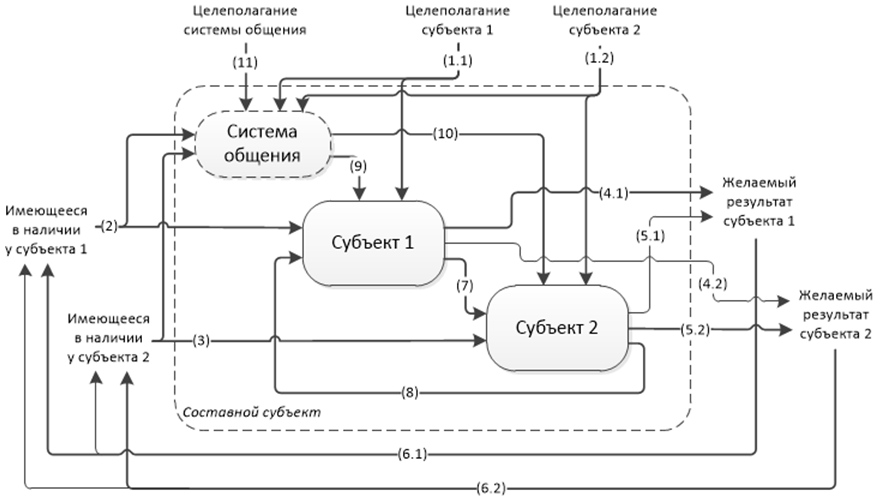
Harmonious symbiosis of the
Results could become two only because each of the subjects got their own goal-setting, therefore instead of one arrow (1) there were two incoming bundles of arrows: (1.1) and (1.2).
Unlike the “If Everything” scenario, the “Invaluable Communication” and “Symbiosis” scenarios are not particularly sensitive to the temporary disappearance of the ability to get the desired results. Subjects do not leave the process, but continue communication (arrows 7 and 8). In principle, the system can remain stable for centuries, over the life of many generations. For example, supporters of some religions from year to year are waiting for the fulfillment of the prophecy, they are diligently preparing for it, and are not particularly worried about the fact that it does not occur at all.
The result of symbiosis can (and should) be considered as a composite subject, which has a set of goal setting, a set of resources and achieved results. Further, this composite subject can already be included as an independent unit in further system formation according to any of the scenarios considered here.
Obviously, the scheme turned out to be too complicated in order to spontaneously arise at once somewhere entirely from nothing. But the existence of harmonious symbiosis is a universally observed fact in the living world, and we have no choice but to find out how such complex structures can arise from simpler ones. For example, consider how symbiosis can arise from the interaction of a predator and a prey. At the beginning of the process, we have a potential prey and a hungry predator (the arrows are numbered so that later we get a picture similar to the “Symbiosis” scenario):

The potential prey and the hungry predator
Having found the prey, the predator takes the result from the prey: The

predator ate the prey
Pure predation is not a very profitable strategy, since natural selection works against potential victims to continue to be easy prey. The only way for a predator to turn off the unfavorable evolution of its victims is to stop eating victims to death. That is, to stop being a predator, and become a parasite:

Parasitism
At this stage, the victim and the former predator have a jointly solved task - by joint efforts to ensure that parasitism does not turn back into predation. The only way to do this is to set up a communication channel through which the victim will signal to the parasite that its resource has been critically reduced. A signal arrow (7) is formed from the victim to the parasite, as well as the context necessary to interpret the signal (10). And since one-way communication is inefficient, a reverse channel appears (arrow 8) and the context to it (9). Having synchronized informational contexts of the victim and the parasite, we are forced to state the formation of a system of communication and an integral subject. Result:
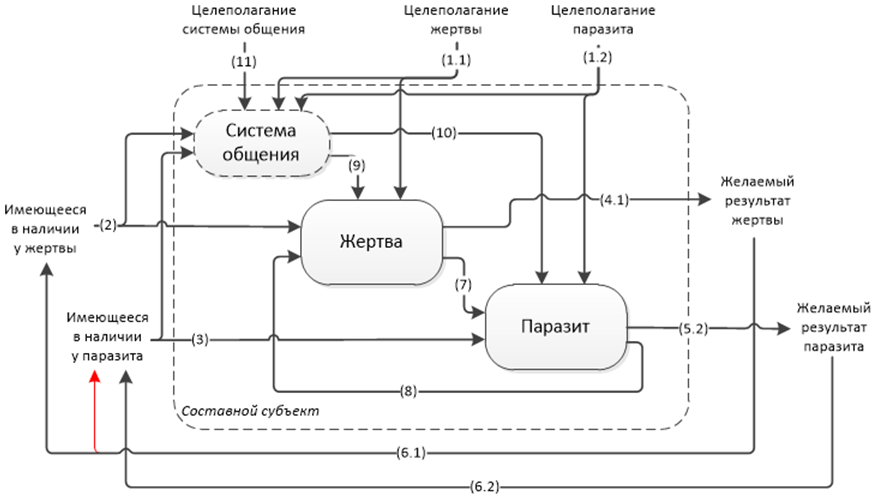
Enlightened parasitism The
arrow, for which, as a result, everything started, highlighted in red. Before symbiosis, it remains to ensure that the result of the parasite’s activity becomes useful to the victim and / or include joint work on the desired results. When this happens, participants in the process should no longer be spoken of as victims and parasites. They become symbionts.
If we consider the relationship of civil society with the state, it is noticeable that in this case, the state always first acts as a predatory gang of robbers, and only as the situation evolves, the process flows into a more or less peaceful parasitism. Some of the most developed states now observed have already been able to overcome their own greed and move on to a more evolutionarily beneficial model of enlightened parasitism with elements of symbiotic relations.
In principle, the reverse process is also real - from symbiosis to parasitism, and further to pure predation. But it can be argued that, in general, the dominant vector of development is directed towards symbiosis, since from the point of view of natural selection it is more profitable. In the future, if the value of the desired results to the symbiotes themselves ceases to be obvious, the “Symbiosis” scenario may turn into a “Self-Essential Communication” scheme.
In the above schemes, of course, the most mysterious, and therefore interesting entities are communication systems. Despite the fact that they are physically realized in the form of subsystems of interacting subjects, we, nevertheless, have every right to speak of them as systems with integrity. Among other things, there is every reason to assume that it is common practice for self-replicating communication systems to recruit subjects into symbiotic relationships. Or even not recruitment, but targeted cultivation.
From the point of view of the subject involved in the symbiotic relationship (that is, from within the system), the functioning of the communication system looks like the presence of an additional goal setting, closely related to the satisfaction of the original goal setting for which the system was created. In particular, a market economy is a prime example of symbiotic relationships. When entering into commodity-money relations, the subject begins to desire not only material goods (the initial motivation of the subjects), but also money that cannot be considered material goods, at least for the reason that they are intangible (because, as it was previously emphasized, can be transmitted via the Internet). But the informational nature of money escapes us, participants of market relations. Having received a hundred-dollar bill, we sincerely believe that we have taken possession of value, although,if you think about it, it becomes obvious that the intrinsic consumer value of this artifact is approximately zero. A hundred-dollar bill is a material carrier of a signal, the meaning of which is that the owner of this object has a desire to get rid of this object rationally, and there are a number of other subjects who want to get this object, so that later, in turn, from it in a reasonable way get rid of. It turns out the data network, familiar to us from childhood, in which we ourselves, business entities, play the role of the transport medium. But if the signals are transmitted, then, obviously, they must have senders (someone must encode information into the signal), and recipients. It can be assumed that in this case money exchange is an internal information process of that mysterious impersonal entity,which can be referred to as the “market economy communication system”. And for us, economic entities, it is quite enough that we have an external goal-setting, expressed in the desire to get the money that we do not have, and to spend the money that we have.
With all the complaints, a purely symbiotic system of a market economy is systematically more profitable and more humane than any other system, based either on slavery or on the idle “If everything” scenario. As a spoon of tar in this big barrel of honey, of course, there are always places where parasitism and even predation is present, appearing where, for some reason, the balance of mutual interest of symbionts is disturbed.
As applied to social symbiotic systems, the worst thing is not the appearance of predation and parasitism, but the fact that in such systems the element that determines the essence and direction of the processes takes place is not something concrete, visible and tangible, but some kind of incomprehensible virtual personalized essence . In such a setting, we feel uncomfortable, and a natural desire arises to materialize the system-forming link. For example, and it is natural to appoint a specific person as the leader of what is happening. Best of yourself. Or, if this idea is not welcomed by everyone, then the mythical anthropomorphic God, but to appoint yourself as his main prophet. If this succeeds, the “symbiosis” scenario becomes the “slavery” scenario. If we do not want to implement the “slavery” scenario, then we must learn to abandon the idea of usurpation,and from the idea of personification of communication systems.
Prevent and destroy
Systems can be useful not only to create, but also to destroy. Even seemingly such an idyllic system as a harmonious symbiosis can become undesirable to us. We may want to break it at least in order to create another symbiotic system more appropriate to the changed circumstances in the vacated space.
Speaking about the breaking of systems, it is useful to immediately focus on whether we act from inside the system or from the outside. The motivation for breaking up from the inside can obviously be that the subject has ceased to be satisfied with his involvement in the process. Motivation to break up from the outside is more diverse, but also obvious.
The most radical way to break systems is, of course, the destruction of the subjects participating in them, but we will not consider this method not so much for humanism reasons, but because we have another task: we are not talking about the destruction of system elements, but about the destruction of systems.
Deconstructing the “use of instrument” scenario
Let me remind you the scheme:

The motive for deconstructing such a system may be that using a particular instrument, in addition to a very positive for the subject of achieving the desired result, also has undesirable side effects. For example, if the desired result is the acquisition of spiritual comfort, and the tool is a syringe with heroin.
In such a situation, simply taking the instrument away from the subject is not an effective deconstruction. The subject, deprived of the instrument, receives deprivation of the desired result, and with goal setting that is nowhere in place, he finds a way to regain a similar instrument. An effective solution is to replace the “use tool” scenario with any other scenario that effectively gives the subject the desired result.
Deconstruction of slavery
Scheme:

The slaveholding system operates with the hands of slaves, and therefore slaves become the first enemies in a clash with such systems. However, it must be understood that such systems are a renewable resource, and the withdrawal of slaves from the system, although unpleasant to the slave-owning system, is still not lethal to it. After suffering losses and retreating to pre-fortified positions, the system will recuperate and try to take revenge. That is why large-scale epic battles, although they provide incomparable material for mythology, literature and cinema, still cannot be considered an effective means of deconstructing slave-owning systems. A more correct approach is the neutralization of the slave-owning subject, but the difficulty here is that, firstly, the subject is usually reliably protected and, secondly, it is not even always possible to correctly identify him.Having a habit of personifying a subject, we traditionally assign the person who we can see with our eyes — the king, emperor, dictator, president, or, as an option, a narrow circle of people — to the role of slave owner. But, even having finally won the war and eliminated the personified master, we may after some time be surprised to find that this, too, did not become a mortal wound for the system. The unfinished system successfully grows a new top for itself, compensates for the loss of slaves, and again appears before us in a renewed and refreshed form.after some time we may be surprised to find that this, too, did not become a mortal wound for the system. The unfinished system successfully grows a new top for itself, compensates for the loss of slaves, and again appears before us in a renewed and refreshed form.after some time we may be surprised to find that this, too, did not become a mortal wound for the system. The unfinished system successfully grows a new top for itself, compensates for the loss of slaves, and again appears before us in a renewed and refreshed form.
The weakest place of slavery is not slaves and not obviously observable host subjects, but the need to block a slave’s own external goal-setting. Accordingly, the basis of the method of getting rid of slavery can be the release of the blocked channel. As soon as the slave begins to understand that the purpose of his existence is not only serving the master, he ceases to be an effective slave, and the system cracks. When the slaves' external goal-setting is finally unblocked, the slave-owning system ceases to exist simply because the former slaves cease to react to the control actions (signal 3 in context 6) and disperse each in his own affairs.
Interestingly, the situation of the release of the goal-setting of a slave is called “corruption”. Now corruption is considered to be a strictly negative phenomenon, with which it is necessary to fight with all our might. Tactically, corruption can probably be viewed as something undesirable, but strategically, the corruption of slaves is precisely the tool that most effectively destroys slave systems. By the way, in those systems in which the “slavery” scenario is not used, the concept of “corruption” is generally inapplicable. Corruption is, after all, nothing but the natural behavior of subjects in a situation where it is considered unacceptable in the interests of the “common good”, “age-old traditions”, or some other lofty lie.
The key to understanding how a particular slave system can be deconstructed and transformed into something more appropriate is finding an answer to the question “what can be changed in what is happening so that the concept of“ corruption ”becomes in general inapplicable?”
Delegation deconstruction
Scheme:

A very sad situation, especially for the subject himself, who from the subject of the actor has turned into an inactive non-subject. The only thing that can be offered here is to bite your teeth into the process, despite all the costs and all the seeming absurdity of your own participation in obtaining the desired result. If the created slave has effective protection from intercepting the field of activity, then we can try to enter into a symbiosis with him, but not through the seemingly logical scenario “slave slave”, but in the correct natural way. For example, to start through predation and parasitism.
Deconstructing the “If Everything”
Scenario This scenario does not need to be deconstructed, since it is not present anywhere in a working form in the real world.
Deconstruction of symbiosis
Symbiosis is a good and positive thing. Even a pity to break the idyll. But if you still need to break it, then the ability to do it correctly will be useful. Let me remind the scheme: The

key element of the symbiotic system is the communication system that sets contexts (9 and 10) for horizontal information links (7 and 8). Accordingly, in order to destroy the symbiosis, it is necessary to make sure that the signals circulating in the system are no longer adequately interpreted. As soon as the symbionts cease to understand each other, the system quickly degrades into a much less tenacious predation or slavery.
Scenarios of “joint work on a common result”, “self-help communication” and “enlightened parasitism”, which are special cases of symbiosis, are deconstructed in the same way, that is, through the neutralization of the communication system.
General note on the deconstruction of systems
Any operating system is a way to solve a problem. If, before proceeding with deconstruction, we did not create at least an equally effective alternative way to solve the same problem, our deconstruction would not be successful. Thus, a necessary component of the solution of the “prevent and destroy” problem becomes the successful solution of the “create and maintain” problem.
Conclusion
The central thought of any information philosophy, not necessarily only disclosed here, can be expressed in just three words: stop the reification of information . While we are trying to talk about information as something objectively existing, regardless of consciousness, we are not talking about information.
By banning our reification, we immediately find ourselves in a very difficult situation, due to the fact that, firstly, we now can’t ignore the need to learn to talk about intangible things, and secondly, we somehow need to restore the integrity of the world.
The solution of these problems was significantly contributed by the instrumental approach to philosophizing, which was indicated in the Introduction. Without its application, we could not advance further the discussion in the spirit of "whether information exists (as well as systems, subjects, causality, time, etc.) in fact, or is it all just an illusion."
In the course of solving the problem of rejecting the information, it was possible to:
- Construct a situational-dependent rationale , allowing to build reliable knowledge where it has not been practiced before.
- Using the signal-context construction , to bridge the bridge between the material and non-material worlds, thereby connecting them into a single whole.
- «» «» . , , , , .
- «» , .
- «» .
- , .
- , .
- , .
- .
- .
- , .
- - .
- .
- , . , .
- .
- .
Perhaps someone expected from the philosophy of information a recipe for establishing total control over everything that happens. In the end, it turned out all the opposite. It turned out that the establishment of total control is possible only through the complete destruction of one’s own subjectivity. Understanding this circumstance in the future may have some influence on the reversal of the vector of social development from the desire for maximum centralization to the desire for properly and harmoniously organized freedom.
What is especially valuable and can not but rejoice is the fact that in the resulting metaphysical system, everything that somehow can be attributed to mysticism - gods, demons, subtle matter, other worlds and so on - all this has been transferred to the category superfluous entities, without which one can and must be able to manage. ” The ideas proposed for replacement — in the signal-context construction, in systems, in identities, and even in frighteningly diverse transpersonal sources of external goal-setting — are not the slightest otherworldly. All that is said is available for observation, judgment and productive use.
In my narrative, I diligently avoided the moral and ethical side of all the issues under consideration. This is done not because the topic is not interesting, but because mixing metaphysics with axiology is the surest way to get a product of unacceptable quality from both points of view. No doubt, from the axiological position, the topic considered here should also be carefully worked out, but I would prefer that this should be done by those who understand me better than such issues.
That ended our marathon. Those who could run it from beginning to end and not go crazy, you know, I am proud of you. Regardless of the coincidence of our ideological positions. Those who could only master it partially, I hope you also got your piece of pleasure.
Important note. It’s hard to believe, but I really don’t have any idea what to do next with this text. Fantasy has never gone further than “publish on Hiktatimes.” If you have thoughts on this topic, do not keep in yourself, write in comments or in a personal. If you have acquaintances (or acquaintances of acquaintances) professionally dealing with the issues discussed here, do them a good deed, slip this text with them and hint that I am open to communication regardless of how far these seven discussion threads have sunk into history.
Source: https://habr.com/ru/post/403907/
All Articles